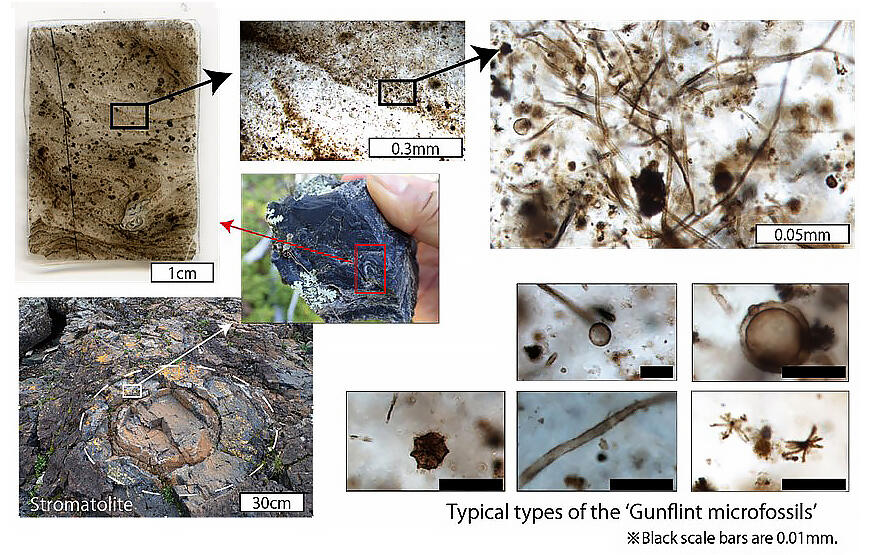The research team of Postdoctoral Research Fellow Kohei Sasaki, Assistant Professor Akizumi Ishida, and Professor Takshi Kakegawa of the Graduate School of Science, Tohoku University, along with Professor Emeritus Yuji Sano (currently at the Center for Advanced Marine Core Research, Kochi University) and Research Associate Naoto Takahata of the Atmosphere and Ocean Research Institute, the University of Tokyo, conducted a stratigraphic survey in the Gunflint Formation (Canada) from approximately 1.9 billion years ago to reevaluate the Gunflint microfossils and discovered five types of organic microstructures that are morphologically distinct from the conventional Gunflint microfossils: colonial, ellipsoidal, with intracellular inclusions (ICIs), spinous-type, and tail-bearing types. Furthermore, these five microstructures proved to be new types of microfossils.

Provided by Tohoku University
The newly discovered colonial-type microfossils had already established a system in which multiple cells coexisted in a clumped form. The colony formation is clearly different from conventional microfossils, in which individual cells exist independently, and can be seen as the beginning of a change toward the next evolutionary stage of "symbiosis." Based on their morphological characteristics, the ellipsoidal microfossils were judged to be analogous to the dormant cells produced by modern cyanobacteria called akinete.
When exposed to environmental stresses such as temperature, sunlight, or nutrient deficiency, cyanobacteria enter a state of dormancy by concentrating nutrients in specific cells. This suggests that the discovery of akinete-like microfossils indicates that prokaryotes at that time had already adopted a survival strategy that is similar to that of modern organisms. This mechanism of storing nutrients inside cells is also seen in the microfossils encapsulating cellular tissues, and this discovery can be seen as evidence that prokaryotes evolved in response to the environment in the oceans at a time when rapid environmental changes are thought to have occurred.
On the other hand, the protruding structures seen in the tail-bearing type and spinous-type microfossils are thought to be advantageous for locomotion, for expanding the organism's nutrient acquisition range, and for nutrient transfer with other individuals, and are characteristic of highly morphologically evolved eukaryotes. Although they cannot be definitively classified as eukaryotic microfossils because their size and membrane characteristics do not fit the current definition of eukaryotes, they make clear for the first time that by this time period prokaryotes had already evolved to become functionally similar to eukaryotes.
According to Sasaki, "1.9 billion years ago was the age after the greatest increase in the Earth's oxygen concentration in the history of the planet, and also the age when our ultimate ancestors, the eukaryotes, began to emerge. These microfossils embody the uncertain ecology of such a turbulent time. Although it was difficult to observe microfossils smaller than 0.1 mm, in the future we would also like to conduct chemical analysis for trace metal elements, including on the new types of microfossils, to identify specific species of organisms. We will clarify the geological environment at that time, which was the driving force behind the diverse evolution found in this study, and bring to light, from the perspective of geoscience, the actual state of co-evolution of life and the earth."
■ Stromatolite
A dome-shaped rock formed by multiple layers of cyanobacteria and other microorganisms and clastic materials such as sand.
It is formed in shallow water and other light-bearing layers.
■ Cyanobacteria
Oxygen-producing photosynthetic bacteria.
Spherical and filamentous microfossils found in the Gunflint Formation are thought to be closely related to cyanobacteria.
Journal Information
Journal: Precambrian Research
Title: Evolutionary Diversification of Paleoproterozoic Prokaryotes: New Microfossil Records in 1.88 Ga Gunflint Formation
DOI: 10.1016/j.precamres.2022.106798
This article has been translated by JST with permission from The Science News Ltd.(https://sci-news.co.jp/). Unauthorized reproduction of the article and photographs is prohibited.




